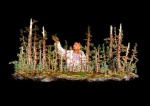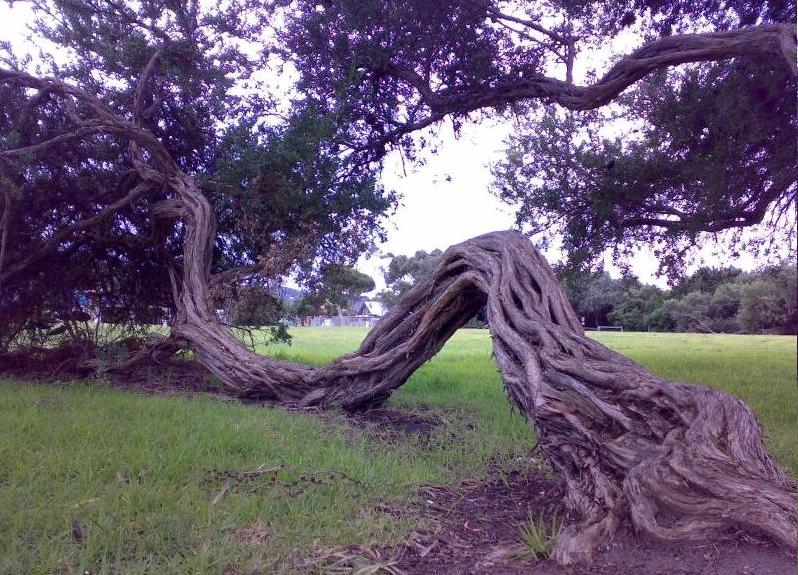Bonsai styles of the world
+8
Ravi Kiran
kcpoole
bucknbonsai
Russell Coker
krazykangaroo
JimLewis
Bob Pressler
sunip
12 posters
Page 1 of 1
 Bonsai styles of the world
Bonsai styles of the world
Used to our own regional interpretation of the older and newer Chinese-Japanese design styles to express ourselves,
it is refreshing to find for example the link to The Pretoria Bonsai Kai.
www.pretoriabonsaikai.org
There i found a page about a book from Charles Ceronio titled: Bonsai styles of the world.
What do you think about the Baobab style, the Pierneef style, the Buschveld style or the Elbow or Wonderboom style?
How many regions have found names for their own characteristics?
Or is just -free style- sufficient next to moyogi chokkan and so on?
Regards, Sunip
sunip- Member
 Re: Bonsai styles of the world
Re: Bonsai styles of the world
I have a copy of his book from the first publishing and think it's awesome. While some of the syles were not my cup of tea I've found it to be an inspirational book.
Especially when I have a piece of material I'm not sure where to go with it, i"vbe flipped through that book and have benn inspired more than once.
An excellent book that opened my eyes to new possibilities in terms of bonsai styling.
Especially when I have a piece of material I'm not sure where to go with it, i"vbe flipped through that book and have benn inspired more than once.
An excellent book that opened my eyes to new possibilities in terms of bonsai styling.

Bob Pressler- Member
 Re: Bonsai styles of the world
Re: Bonsai styles of the world
I have the new and older editions and refer to them frequently.
As to any feelings about the styles you mentioned, they are South African styles for South African trees and as such they are fine. I can't imagine designing a maple to the Baobab style, for instance. Maybe a Jade. (?)
I think someone here was asking about making one of those gawdawful. fat-rooted "ginsing" Ficus into the Baobab style not long ago. I suppose, if you can't stand the idea of throwing them in the trash, that's as good a solution for them as anything.
The book's name is a bit of a misnomer, I suppose, as the only parts of "the world" that are singled out for specific bonsai styles are Japan, China and Mr. Ceronio's Africa. Maybe there are no other continents that have trees that take on such distinctive shapes that a bonsai style can be developed for it, but I wonder . . .
I would think that Australia must have some distinct styling potential because of their distinct flora.
We in North America have the two giant redwoods which grow like no other trees in the world (leaving aside their size) with the massive trunks and foliage that doesn't appear until very close to the top -- more than 2/3 the way up the trunk. But the bonsai you see created of those species mostly seem to look like pine trees, and are quite dull. A redwood style hasn't emerged to my knowledge. There also is the flat-topped bald cypress shape that Vaughn Banting so successfully brought into the bonsai world -- though a lot of BC bonsai are teepee shaped with huge bases and radical taper (the "gee whiz" style). I'd like to see someone develop a "Live Oak" style (the eastern tree with the 100-foot wide canopy!) -- though they'd have to use some other plant as a stand in (perhaps Ilex vomitoria or Buxus mycrophylla).
Does Europe have a continental tree that deserves a distinct style? I've seen some very nice bonsai from Europe, but none that I know are species specific.
How about South America?
S.E Asia and India (and other tropical parts of the world) have, I guess, the various Ficus/banyan styles which seem to have become established bonsai forms.
This could be fun.
As to any feelings about the styles you mentioned, they are South African styles for South African trees and as such they are fine. I can't imagine designing a maple to the Baobab style, for instance. Maybe a Jade. (?)
I think someone here was asking about making one of those gawdawful. fat-rooted "ginsing" Ficus into the Baobab style not long ago. I suppose, if you can't stand the idea of throwing them in the trash, that's as good a solution for them as anything.
The book's name is a bit of a misnomer, I suppose, as the only parts of "the world" that are singled out for specific bonsai styles are Japan, China and Mr. Ceronio's Africa. Maybe there are no other continents that have trees that take on such distinctive shapes that a bonsai style can be developed for it, but I wonder . . .
I would think that Australia must have some distinct styling potential because of their distinct flora.
We in North America have the two giant redwoods which grow like no other trees in the world (leaving aside their size) with the massive trunks and foliage that doesn't appear until very close to the top -- more than 2/3 the way up the trunk. But the bonsai you see created of those species mostly seem to look like pine trees, and are quite dull. A redwood style hasn't emerged to my knowledge. There also is the flat-topped bald cypress shape that Vaughn Banting so successfully brought into the bonsai world -- though a lot of BC bonsai are teepee shaped with huge bases and radical taper (the "gee whiz" style). I'd like to see someone develop a "Live Oak" style (the eastern tree with the 100-foot wide canopy!) -- though they'd have to use some other plant as a stand in (perhaps Ilex vomitoria or Buxus mycrophylla).
Does Europe have a continental tree that deserves a distinct style? I've seen some very nice bonsai from Europe, but none that I know are species specific.
How about South America?
S.E Asia and India (and other tropical parts of the world) have, I guess, the various Ficus/banyan styles which seem to have become established bonsai forms.
This could be fun.

JimLewis- Member
 bonsai styles of the world
bonsai styles of the world
I just saw the thread on the general discussion from 15 dec.
"Time lags seen when fine art movements move to other practices"
Bonsai means for me expressing myself, its like a mirror where i learn about myself.
If i want to use it as a language, there is the question if another understands what i wanted to express.
We need mutual signs we agree on.
I observe that bonsai styles are helping in this.
Relying on others intuition to understand, is not always enough.
Thinking on artist there are those who just expressing themselves, being as it is, is not enough though.
Art historians like to categorize and invent styles, in that way they understand each other and put individuals together.
Strange thing is that you got artist who choose one of those invented styles to work in,
sometimes because they like it, sometimes because they maybe think there is nothing else, or because they are afraid for not getting understood?
All fine and human i feel.
So thing is, styles are artificially, just a tool.
They are helpful specially for those who just want to give it try, or for example having categories in exhibitions.
If we use those categories we have to remind us that we are using them.
Because behind all of that, maybe far hidden, (unconsciously), there is some sort of ideal you want to express, not bound to anything like a style.
There starts the not categorized.
But having said this even in a fine, lets say fukinashi, something of the not categorized expression can shine
and being appreciated for those who recognize it.
Playing bonsai i have to be conscious of the car and the driver.
regards, Sunip
"Time lags seen when fine art movements move to other practices"
Bonsai means for me expressing myself, its like a mirror where i learn about myself.
If i want to use it as a language, there is the question if another understands what i wanted to express.
We need mutual signs we agree on.
I observe that bonsai styles are helping in this.
Relying on others intuition to understand, is not always enough.
Thinking on artist there are those who just expressing themselves, being as it is, is not enough though.
Art historians like to categorize and invent styles, in that way they understand each other and put individuals together.
Strange thing is that you got artist who choose one of those invented styles to work in,
sometimes because they like it, sometimes because they maybe think there is nothing else, or because they are afraid for not getting understood?
All fine and human i feel.
So thing is, styles are artificially, just a tool.
They are helpful specially for those who just want to give it try, or for example having categories in exhibitions.
If we use those categories we have to remind us that we are using them.
Because behind all of that, maybe far hidden, (unconsciously), there is some sort of ideal you want to express, not bound to anything like a style.
There starts the not categorized.
But having said this even in a fine, lets say fukinashi, something of the not categorized expression can shine
and being appreciated for those who recognize it.
Playing bonsai i have to be conscious of the car and the driver.
regards, Sunip
sunip- Member
 Re: Bonsai styles of the world
Re: Bonsai styles of the world
It's your thread, so you can take it where you want -- even to another discussion of "art."
I'm interested in bonsai "styles" because I'm interested in trees. I like making bonsai that look like trees, and
when "art" enters the picture, I kinda feel we lose the trees.
I'd really like to know if people can identify bonsai styles that go with their native trees.
Too many Casuarina are styled to look like pines. Does anyone down where they are native (Florida and Hawaii don't count; they're escaped pests in those states) design Casuarina bonsai to look like Casuarina?
In Brazil, does anyone do Bougainvillea bonsai the viny way they grow in the wild?
I've just recalled a good European tree that may be a European style -- Olea europea. But do you style it as it really grows?
I'm interested in bonsai "styles" because I'm interested in trees. I like making bonsai that look like trees, and
when "art" enters the picture, I kinda feel we lose the trees.
I'd really like to know if people can identify bonsai styles that go with their native trees.
Too many Casuarina are styled to look like pines. Does anyone down where they are native (Florida and Hawaii don't count; they're escaped pests in those states) design Casuarina bonsai to look like Casuarina?
In Brazil, does anyone do Bougainvillea bonsai the viny way they grow in the wild?
I've just recalled a good European tree that may be a European style -- Olea europea. But do you style it as it really grows?

JimLewis- Member
 Re: Bonsai styles of the world
Re: Bonsai styles of the world
In Australia we have hundreds of species of casuarinas and many of them actually do look similar to pines, although a little bit more weeping. Of course the pines here tend to have upright branches rather than the downward growing ones how they grow in the northern hemisphere.
A style that I have been wanting to try is 'arch, or bridge' which I call our red gum trees that get too heavy sometimes and fall to their leaning side, then grow one or more trunks up from the middle. They look just like a bridge.
Cheers,
Rowan
A style that I have been wanting to try is 'arch, or bridge' which I call our red gum trees that get too heavy sometimes and fall to their leaning side, then grow one or more trunks up from the middle. They look just like a bridge.
Cheers,
Rowan
krazykangaroo- Member
 Re: Bonsai styles of the world
Re: Bonsai styles of the world
What a fun thread, hopefully y'all won't turn it into another "Viewing Distance" diaster.
The Japanese came up with thier styles - formal upright, informal upright, etc - based on the trees they saw around them. But they also saw the differences between and informal upright Japanese black pine and an informal upright Japanese maple. I think this is the crux of what beginners miss - deciduous trees don't look like evergreen trees. When you factor into the equasion people from all over the world using material for bonsai that the Japanese never dreamed of - well, the sh*t really hits the fan. I think back in the '70's and early '80's is when the Japanese started to realize that people around the world were styling their bonsai like the trees around them - and it was a wonderful thing. Flat top balb cypress from the South-east USA, or flat top baobabs and acaias from Africa, ficus or live oak, they can be extraordinary bonsai - and look nothing like Kokufu-ten.
R
The Japanese came up with thier styles - formal upright, informal upright, etc - based on the trees they saw around them. But they also saw the differences between and informal upright Japanese black pine and an informal upright Japanese maple. I think this is the crux of what beginners miss - deciduous trees don't look like evergreen trees. When you factor into the equasion people from all over the world using material for bonsai that the Japanese never dreamed of - well, the sh*t really hits the fan. I think back in the '70's and early '80's is when the Japanese started to realize that people around the world were styling their bonsai like the trees around them - and it was a wonderful thing. Flat top balb cypress from the South-east USA, or flat top baobabs and acaias from Africa, ficus or live oak, they can be extraordinary bonsai - and look nothing like Kokufu-ten.
R

Russell Coker- Member
 Re: Bonsai styles of the world
Re: Bonsai styles of the world
I dont know how to get peoples quotes highlighted but I know how to cut and paste-- "I'd like to see someone develop a "Live Oak" style (the eastern tree with the 100-foot wide canopy!) -- though they'd have to use some other plant as a stand in (perhaps Ilex vomitoria or Buxus mycrophylla)"
Joe day has a boxwood in the live oak style. Its one of my favorite trees Ive ever seen as I spent hours under the angel oak in south carolina one day and Joes bonsai really brought me back.
Joe day has a boxwood in the live oak style. Its one of my favorite trees Ive ever seen as I spent hours under the angel oak in south carolina one day and Joes bonsai really brought me back.

bucknbonsai- Member
 Re: Bonsai styles of the world
Re: Bonsai styles of the world
W have some wonderful artists in Australia working with our own plants and developing them in an Australian way
we have a very active local forum, encouraging the use of Australian plants as Bonsai and trying to develop out own natural looking Styles withthem
check us out here and on the banner you see a few examples of some of our trees.
http://www.ausbonsai.com/forum/
Ken
we have a very active local forum, encouraging the use of Australian plants as Bonsai and trying to develop out own natural looking Styles withthem
check us out here and on the banner you see a few examples of some of our trees.
http://www.ausbonsai.com/forum/
Ken
kcpoole- Member
 Re: Bonsai styles of the world
Re: Bonsai styles of the world
One style we have in the UK that interests me hugely, is the trees that have been harvested by man for their timber for many centuries. Boat and ship building, timber framed houses, or for industrial use. These veteran trees have way out lived their untouched brothers and sisters. With coppicing and pollarding techniques, re-generation has extended their life. Grotesque would describe them well, but also very beautiful, magical and mystical.

Last edited by will baddeley on Fri Jan 14, 2011 12:29 pm; edited 1 time in total
Guest- Guest
 Re: Bonsai styles of the world
Re: Bonsai styles of the world
Thanks Sunip for starting a wonderful thread. I am sure it'd go a long way and like Russel said hopefully it should go the right way unlike....
Jim,
I have read your comments with great joy and admiration . I must admit that I am pleasantly surprised at your views. My first impressions were probably very different and I am glad that I am proved wrong. One small point of disagreement or should I rather say debate. While I am fully for styling specific tree species as per their natural styles. However should that be restricted to the specific species only. What I am saying is should ONLY a Bald Cypress be styled as a Flat Top style or can other species too be styled in that style. I believe that in Bonsai design it is important to have as many styles as possible, drawing inspiration from trees all over the world. Having done that the designs could be extended across species without restricting them to their respective natural styles. This IMHO would inhibit the creativity of the Bonsaist. What are your views on this.
. I must admit that I am pleasantly surprised at your views. My first impressions were probably very different and I am glad that I am proved wrong. One small point of disagreement or should I rather say debate. While I am fully for styling specific tree species as per their natural styles. However should that be restricted to the specific species only. What I am saying is should ONLY a Bald Cypress be styled as a Flat Top style or can other species too be styled in that style. I believe that in Bonsai design it is important to have as many styles as possible, drawing inspiration from trees all over the world. Having done that the designs could be extended across species without restricting them to their respective natural styles. This IMHO would inhibit the creativity of the Bonsaist. What are your views on this.
Rowan
A very interesting post. Did you mean something like this in the pic below...

Regards
Ravi
Jim,
I have read your comments with great joy and admiration
Rowan
A very interesting post. Did you mean something like this in the pic below...

Regards
Ravi

Ravi Kiran- Member
 Re: Bonsai styles of the world
Re: Bonsai styles of the world
Yes partly. Our redgums fall like that and sometimes the top still survives but at other times the top dies off, or stops growing as strongly and a new trunk grows up from the centre of the 'bridge' I will try and get a photo in the next couple of days.
krazykangaroo- Member
 bonsai styles of the world
bonsai styles of the world
Some thoughts.
The atmosphere of a huge ancient plane, olive or oak is unforgettable, also a young flowering tree in a meadow can give us a fine and light emotion.
Jim expressing that in a tree and doing that in a way a specific species is growing is a sort of art i feel.
Art as meant before is much about he ability to express yourself.
Should we talk of a tree styled in the nature of a young pine, old pine, and then further an old bridge pine, young windswept pine?
A free standing ancient oak, a young prunus grown under a light canopy, a old larix grown in a dense forest or indeed
a ancient oak used for timber (they have a name for that)?
A tree is developing sometimes in a shape similar to other trees because of circumstances, should we take that into account to?
It would be a challenge to find the subtile ways and marks that a maple is, although it is growing different, still is a maple,
not losing the tree but expressing for example the behaviour of a beech on a slope.
A description of a certain tree rather then style?
Did you see the old postcards Toche posted on the IBC.
I see trees in pots, put in there because the gardener found something appealing about them.
Maybe for decorative ore emotional reasons, some are styled a bit to accentuate those quality's, others got further
and became (bonsai). Al fine i think.
regards, Sunip
The atmosphere of a huge ancient plane, olive or oak is unforgettable, also a young flowering tree in a meadow can give us a fine and light emotion.
Jim expressing that in a tree and doing that in a way a specific species is growing is a sort of art i feel.
Art as meant before is much about he ability to express yourself.
Should we talk of a tree styled in the nature of a young pine, old pine, and then further an old bridge pine, young windswept pine?
A free standing ancient oak, a young prunus grown under a light canopy, a old larix grown in a dense forest or indeed
a ancient oak used for timber (they have a name for that)?
A tree is developing sometimes in a shape similar to other trees because of circumstances, should we take that into account to?
It would be a challenge to find the subtile ways and marks that a maple is, although it is growing different, still is a maple,
not losing the tree but expressing for example the behaviour of a beech on a slope.
A description of a certain tree rather then style?
Did you see the old postcards Toche posted on the IBC.
I see trees in pots, put in there because the gardener found something appealing about them.
Maybe for decorative ore emotional reasons, some are styled a bit to accentuate those quality's, others got further
and became (bonsai). Al fine i think.
regards, Sunip
sunip- Member
 Re: Bonsai styles of the world
Re: Bonsai styles of the world
What I am saying is should ONLY a Bald Cypress be styled as a Flat Top style or can other species too be styled in that style.
This is only my opinion, but I'd feel that only trees which have that habit of growth should be turned into bonsai with that habit of growth. In the SE coastal USA, that includes bald cypress, and some of the mature pines. There appear to be similar species with that growth habitat in Africa. I don't recall seeing them elsewhere.
Forcing some other wild tree into a "style" that isn't natural to it does not appeal to me. It makes bonsai look unnatural. Someone, elsewhere, called them "sculptures." I've never liked that analogy. As I said, I feel that often, when the maker of a tree decides that he or she is an "artist," the tree-ness of his concoctions often disappears.
I realize that I'm disagreeing with myself when I recommend using species such as boxwood to represent a tree such as the southern live oak, but then, what is the natural shape of a boxwood -- a square cut hedge? A topiary of Mickey Mouse? <g> They've been domesticated so long they've forgotten what they looked like "in the wild."

JimLewis- Member
 bonsai styles of the world
bonsai styles of the world
Jim Lewis wrote:
As I said, I feel that often, when the maker of a tree decides that he or she is an "artist," the tree-ness of his concoctions often disappears.
Yes Jim i can feel that.
When you experience for example those Methusale pines you got over there, i imagine one feels a certain awe.
They are not only decorative, our personal differences and abilities to feel and appreciate coming in here.
One pictures a thunder strike or a dragon or what ever and you got a certain energy from it
If you like a neat garden like al other neighbours you might find those old things maybe a bit messy and disturbing (or pleasant disturbing).
For the bonsaist i can imagine when you have a pine in you garden, who is suitable for that,
something of that awe is coming in to the work on that tree. One is inspired by it.
When that is coming into a tree, why would it not be called a bit of art?
Of course, let say it just as an example; KIMURA??
The Italians love it, because (amongst others) in the decorative movements and barok quality they recognize their Grande Emozione (i feel)?
Also the Japanese might feel in the same quality something of the powers of nature appreciating it in accordance to their own nature.
Are those bonsai trees?
Let say in a different way, altered as they are by man and not by nature, the bonsaist chosed to accentuate some qualities to express
himself. ( Stop any human expressing himself and he will die)
Ahh sometimes we need guidlines and styles just for a while, till we are comfortable to let loose?
Strange, how we chain ourselves to those guidelines like live lines, well maybe they are in some way?
regards , Sunip
As I said, I feel that often, when the maker of a tree decides that he or she is an "artist," the tree-ness of his concoctions often disappears.
Yes Jim i can feel that.
When you experience for example those Methusale pines you got over there, i imagine one feels a certain awe.
They are not only decorative, our personal differences and abilities to feel and appreciate coming in here.
One pictures a thunder strike or a dragon or what ever and you got a certain energy from it
If you like a neat garden like al other neighbours you might find those old things maybe a bit messy and disturbing (or pleasant disturbing).
For the bonsaist i can imagine when you have a pine in you garden, who is suitable for that,
something of that awe is coming in to the work on that tree. One is inspired by it.
When that is coming into a tree, why would it not be called a bit of art?
Of course, let say it just as an example; KIMURA??
The Italians love it, because (amongst others) in the decorative movements and barok quality they recognize their Grande Emozione (i feel)?
Also the Japanese might feel in the same quality something of the powers of nature appreciating it in accordance to their own nature.
Are those bonsai trees?
Let say in a different way, altered as they are by man and not by nature, the bonsaist chosed to accentuate some qualities to express
himself. ( Stop any human expressing himself and he will die)
Ahh sometimes we need guidlines and styles just for a while, till we are comfortable to let loose?
Strange, how we chain ourselves to those guidelines like live lines, well maybe they are in some way?
regards , Sunip
sunip- Member
 Bonsai Styles
Bonsai Styles
I'm all for styling a tree according to its natural habit. However, don't forget, there are some trees, mostly the understory group, such as Serissa, Grewia, Neea, and some of the Myrtaceae, that don't grow in any style at all. They are just a collection of lignin & chlorophyll. With them, the bonsai grower is free to style them any way he likes. Have fun.
Iris
Iris

bonsaisr- Member
 Re: Bonsai styles of the world
Re: Bonsai styles of the world
Question. Why can't we use an oak to look like an oak? Why do we have to go to the boxwoods? A newbie question for sure, sorry.
Libby
Libby
bumblebee- Member
 Bonsai Styles
Bonsai Styles
Unfortunately, some of the most magnificent trees that we want to emulate do not lend themselves to bonsai conditions, or in some cases can only be styled by Big Experts, not rank amateurs. Our eastern deciduous oaks are very difficult to use for bonsai, although people try from time to time. The western, southern, and Mediterranean live oaks make good bonsai, but their growth habit is entirely different. Therefore, if you wanted to suggest an Eastern white oak, you would have to style some other amenable species to look like it. (I don't know enough about European oaks to comment on them.)bumblebee wrote:Question. Why can't we use an oak to look like an oak? Why do we have to go to the boxwoods?
Libby
As an example from my own collection, I tried for years to style various Eastern white pines as the Great Tree of Peace of the Iroquois. I tried both collected trees & nursery stock. I know it can be done, but I'm not Nick Lenz.

Finally I gave up and used a Pinus parviflora 'Zuisho.' It works fine and I'm happy with the result.
Iris

bonsaisr- Member
 Re: Bonsai styles of the world
Re: Bonsai styles of the world
Libby, Chris Cochrane re-posted an entry from Louis Fontinals that covers a lot of what Iris is saying.
https://ibonsaiclub.forumotion.com/t5241p90-viewing-distance-in-bonsai#53867
Wood
https://ibonsaiclub.forumotion.com/t5241p90-viewing-distance-in-bonsai#53867
Wood
GaryWood- Member
 Re: Bonsai styles of the world
Re: Bonsai styles of the world
Jim, Iris,
when life is full of Paradoxes, why not Bonsai ?? I guess it is a matter of personal choices and I'd respect that. What I guess is more important is to enjoy the Bonsai Journey. Like Johnny Walker Ad line goes..... KEEP WALKING!!
I guess it is a matter of personal choices and I'd respect that. What I guess is more important is to enjoy the Bonsai Journey. Like Johnny Walker Ad line goes..... KEEP WALKING!!
Talking of styles, it is nice to see Bonsai evolve from the Japanese styles to tree species specific style. Certainly a major step forward for Bonsai..... Makes me happy
Ravi
when life is full of Paradoxes, why not Bonsai ??
Talking of styles, it is nice to see Bonsai evolve from the Japanese styles to tree species specific style. Certainly a major step forward for Bonsai..... Makes me happy
Ravi

Ravi Kiran- Member
 Re: Bonsai styles of the world
Re: Bonsai styles of the world
Please i know im new to bonsai,and the idea is to create a small tree that resembles a large living speices,but does anyone think the same as me and that the person who is creating the tree should have a free hands on and create what he or she thinks is a living piece of art lets face it trees do not conform to any definate shape or even size,such is nature,dont get me wrong bonsai trees are fantastic when they mirror the large wild trees,and i would never would want that to change,i love my new hobby,but my its not easy cheers steve
stephen clarke- Member
 Re: Bonsai styles of the world
Re: Bonsai styles of the world
Hi Jim,
Thanks for posting the images of the Oak. The Boxwood does a commendable job of replicating the second Oak tree pic you have posted.... Keep up the great work.....
Ravi
Thanks for posting the images of the Oak. The Boxwood does a commendable job of replicating the second Oak tree pic you have posted.... Keep up the great work.....
Ravi

Ravi Kiran- Member
 Bonsai styles of the world
Bonsai styles of the world
We have similar old oak trees in Europe.
The european oak species are good for bonsai (but they can grow slowly though)
I saved an oak stump a few years ago who is standing in a pot in the back of the garden (nerbari 30 cm. cross section,
just for the pity (and fun) who knows what comes out of it.
I imagine there is a fine line to be learned to recognize, a line i imagine we push further according to our own ability.
When is something acceptable for you personally, and when you come to a point where you going to put a question mark on your styling?
WHY I DO BONSAI?
WHY I DO IT THE WAY I DO IT?
WHAT IMPACT HAS THE STYLING OF OTHER BONSAIST ON ME?
It is often quoted: "bonsai is about the way, not about the goal" is this our life-style?
Regards Sunip
The european oak species are good for bonsai (but they can grow slowly though)
I saved an oak stump a few years ago who is standing in a pot in the back of the garden (nerbari 30 cm. cross section,
just for the pity (and fun) who knows what comes out of it.
I imagine there is a fine line to be learned to recognize, a line i imagine we push further according to our own ability.
When is something acceptable for you personally, and when you come to a point where you going to put a question mark on your styling?
WHY I DO BONSAI?
WHY I DO IT THE WAY I DO IT?
WHAT IMPACT HAS THE STYLING OF OTHER BONSAIST ON ME?
It is often quoted: "bonsai is about the way, not about the goal" is this our life-style?
Regards Sunip
sunip- Member
 Similar topics
Similar topics» Bonsai Styles
» Multiple styles in one bonsai??
» bonsai styles in nature
» Fine Bonsai Art and Nature - breathtaking images of the world's most notable bonsai coming soon!
» Bonsai World 2013
» Multiple styles in one bonsai??
» bonsai styles in nature
» Fine Bonsai Art and Nature - breathtaking images of the world's most notable bonsai coming soon!
» Bonsai World 2013
Page 1 of 1
Permissions in this forum:
You cannot reply to topics in this forum









